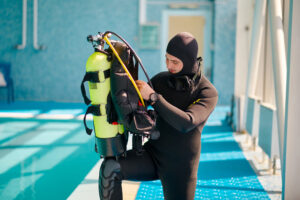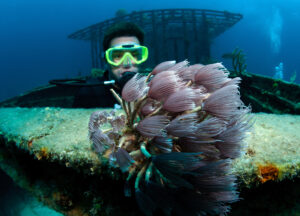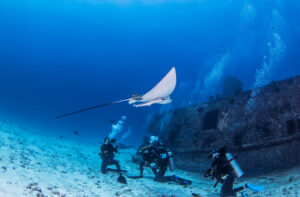What is an LED Dive Light?
LED dive lights are a critical tool for underwater exploration, providing divers with the necessary illumination to navigate and observe their environment. Light Emitting Diode (LED) technology has revolutionized underwater lighting, offering a reliable and efficient source of light that is well-suited for the unique demands of diving. This article explores the history, technological aspects, design features, types, applications, advantages and disadvantages, maintenance, safety considerations, and market trends of LED dive lights.
History and Development
Underwater lighting has undergone significant transformations over the years. Early divers relied on basic handheld torches, which were often cumbersome and unreliable. These initial lighting solutions primarily used incandescent bulbs, which were not energy-efficient and had a limited lifespan. As underwater exploration grew in popularity and complexity, the need for more reliable and powerful lighting became evident.
The introduction of LED technology marked a significant milestone in underwater lighting. LEDs offered a more energy-efficient and durable alternative to traditional incandescent and halogen bulbs. The first LED dive lights appeared in the late 20th century, offering improved brightness and battery life. These early models paved the way for further innovations, leading to the advanced LED dive lights available today.
Over the past few decades, LED technology has continued to evolve. Modern LED dive lights are more compact, powerful, and versatile than ever before. They incorporate advancements in LED efficiency, battery technology, and materials science, making them an indispensable tool for both recreational and professional divers.
Technological Aspects
The core component of an LED dive light is the light-emitting diode itself. LEDs produce light through electroluminescence, where an electric current passes through a semiconductor material, emitting photons. This process is highly efficient compared to traditional light sources, as it generates more light per unit of energy consumed.
Key components of LED dive lights include the LED bulbs, batteries, and housing. LED bulbs are designed to provide high luminosity while consuming minimal power. Modern LEDs can produce thousands of lumens, ensuring excellent visibility underwater. The batteries used in LED dive lights are typically lithium-ion, known for their high energy density and long cycle life. These batteries can power LED dive lights for several hours on a single charge, depending on the light’s intensity and usage patterns.
The housing of an LED dive light is another critical aspect. It must be robust and waterproof, capable of withstanding the pressures of deep dives. Materials like aluminum and high-grade plastics are commonly used for their durability and resistance to corrosion. Advanced sealing techniques, such as O-rings and double seals, ensure that the lights remain waterproof even at significant depths.
Technological advancements have also led to improvements in LED dive light features. These include adjustable beam angles, multiple brightness settings, and even color temperature adjustments. These features allow divers to customize their lighting based on the specific requirements of their dive, enhancing their overall underwater experience.
Design and Features
LED dive lights come in various designs, each catering to different diving needs and preferences. The most common design is the handheld flashlight, which is versatile and easy to use. These lights often feature ergonomic grips and large buttons that can be operated with gloves. Handheld LED dive lights are suitable for general underwater navigation and exploration.
Another popular design is the canister light, which consists of a separate battery canister connected to the light head by a cord. Canister lights are favored by technical divers for their extended burn time and higher light output. They are ideal for deep dives, cave diving, and wreck diving, where reliable and powerful lighting is crucial.
Headlamps are another design frequently used by divers. These lights are mounted on the diver’s mask or helmet, providing hands-free illumination. Headlamps are particularly useful for tasks that require both hands, such as underwater photography or equipment adjustments.
Key features to look for in LED dive lights include the number of lumens, beam angle, waterproof rating, and durability. Lumens measure the total amount of visible light emitted by the light source, with higher lumens indicating a brighter light. Beam angle affects the spread of light, with narrow beams providing focused illumination and wide beams offering broader coverage. The waterproof rating, often indicated by an IPX rating, specifies the depth to which the light can be safely used. Durability features, such as impact resistance and corrosion resistance, ensure that the light can withstand the harsh underwater environment.
Comparing LED dive lights to other types of dive lights, such as halogen and HID (High-Intensity Discharge), reveals several advantages. LED lights are more energy-efficient, have a longer lifespan, and are generally more compact and lightweight. Halogen lights, while cheaper, consume more power and generate more heat. HID lights offer high brightness but are typically bulkier and more expensive than LED lights.
Types of LED Dive Lights
LED dive lights are categorized based on their intended use and design. Primary dive lights are the main source of illumination for a diver. They are typically brighter and have a longer battery life, making them suitable for extended dives and challenging underwater conditions. Primary lights are essential for night dives and deep dives, where ambient light is minimal or nonexistent.
Secondary or backup lights are smaller and less powerful than primary lights. They serve as an emergency light source in case the primary light fails. Backup lights are compact and easy to carry, ensuring that divers always have an additional light source at hand.
Canister lights, mentioned earlier, are a type of primary light but are distinguished by their separate battery canister. These lights are preferred by technical divers for their high output and extended burn time. Canister lights are designed for demanding underwater environments, such as caves and wrecks.
Headlamps provide hands-free lighting and are useful for tasks that require precision and dexterity. They are commonly used in underwater photography and videography, as well as in scientific and commercial diving operations.
Specialty lights, such as UV and video lights, cater to specific diving needs. UV lights, or black lights, are used to highlight fluorescent marine life, revealing vibrant colors that are not visible under normal light. Video lights are designed to provide even and wide illumination, reducing shadows and ensuring high-quality footage.
Applications and Uses
LED dive lights have a wide range of applications, each requiring specific features and capabilities. Recreational diving is one of the most common uses for LED dive lights. Recreational divers rely on these lights for night dives, exploring underwater caves, and enhancing visibility in low-light conditions. The portability and ease of use of handheld LED dive lights make them ideal for casual divers.
Technical and cave diving demand more robust and reliable lighting solutions. Technical divers often venture into deep and complex underwater environments, where reliable lighting is crucial for safety and navigation. Canister lights and high-output primary lights are commonly used in these scenarios, providing the necessary brightness and burn time for extended and challenging dives.
Night diving is another popular application of LED dive lights. Diving at night offers a completely different experience, revealing nocturnal marine life and creating a unique underwater atmosphere. Bright and adjustable LED dive lights are essential for night dives, ensuring clear visibility and enhancing the overall diving experience.
Underwater photography and videography require specialized lighting to capture high-quality images and footage. LED video lights provide even and broad illumination, reducing shadows and highlighting the vibrant colors of marine life. These lights are designed to work in conjunction with underwater cameras and are often adjustable to suit different shooting conditions.
Scientific and commercial diving also benefit from the use of LED dive lights. Marine biologists, researchers, and commercial divers rely on these lights for tasks such as underwater surveys, inspections, and repairs. The durability and reliability of LED dive lights make them suitable for professional use in various underwater applications.
Advantages and Disadvantages
LED dive lights offer several advantages over traditional lighting technologies. One of the most significant benefits is energy efficiency. LEDs consume less power than incandescent and halogen bulbs, resulting in longer battery life. This efficiency is particularly important for divers, as it allows for extended use without frequent battery changes.
Brightness is another advantage of LED dive lights. Modern LEDs can produce extremely high luminosity, ensuring excellent visibility underwater. The ability to adjust brightness levels is also a valuable feature, allowing divers to customize their lighting based on the environment and their specific needs.
LED dive lights are known for their longevity. LEDs have a much longer lifespan compared to incandescent and halogen bulbs, reducing the need for frequent replacements. This longevity, combined with their durability, makes LED dive lights a cost-effective choice in the long run.
However, there are some potential drawbacks to LED dive lights. The initial cost of high-quality LED dive lights can be higher than other types of dive lights. While this cost is offset by the benefits of energy efficiency and longevity, it may be a consideration for budget-conscious divers.
Another potential issue is overheating. While LEDs are generally more efficient and generate less heat than traditional bulbs, they can still overheat if not properly managed. Overheating can affect the performance and lifespan of the light. High-quality LED dive lights typically include heat management systems to mitigate this risk.
Maintenance and Care
Proper maintenance and care are essential to ensure the longevity and reliability of LED dive lights. Regular cleaning is important to remove salt, sand, and other debris that can accumulate on the light’s surface. After each use, especially in saltwater environments, the light should be rinsed with fresh water and dried thoroughly.
Battery maintenance is another crucial aspect. Lithium-ion batteries should be stored in a cool, dry place and charged regularly, even when not in use. Over time, batteries can degrade, so it’s important to monitor their performance and replace them when necessary.
Common issues with LED dive lights include water ingress, battery failure, and LED burnout. To prevent water ingress, divers should regularly check and maintain the O-rings and seals. Battery failure can be mitigated by using high-quality batteries and following proper charging practices. LED burnout is rare but can occur if the light is used improperly or if there are manufacturing defects. It’s important to follow the manufacturer’s guidelines and seek professional repairs if needed.
Best practices for storage and transport include keeping the light in a protective case and avoiding
exposure to extreme temperatures and direct sunlight. Proper storage ensures that the light remains in good condition and is ready for use when needed.
Safety Considerations
Safety is paramount when using LED dive lights. Reliable lighting is essential for maintaining visibility and communication underwater. Divers should always carry a backup light to ensure they are not left in the dark if the primary light fails.
When using LED dive lights, it’s important to be aware of potential hazards. Overheating can occur if the light is used continuously at high settings. Divers should use the light’s adjustable settings to manage heat and battery life effectively.
Backup lights are a critical safety measure. In case of primary light failure, a secondary light ensures that the diver can safely navigate and complete their dive. Backup lights should be easily accessible and checked regularly to ensure they are functioning properly.
Overall, choosing the right LED dive light and following proper maintenance and safety practices are essential for a safe and enjoyable diving experience.
Market Trends and Future Prospects
The market for LED dive lights has grown significantly in recent years, driven by advancements in LED technology and increased demand for high-quality underwater lighting. Current trends include the development of more compact and powerful lights, as well as the integration of smart features such as wireless charging and remote control.
Innovations in battery technology are also shaping the future of LED dive lights. Longer-lasting and faster-charging batteries are being developed, providing divers with even more reliable lighting solutions. Environmental concerns are driving the development of eco-friendly materials and manufacturing processes, making LED dive lights more sustainable.
The future prospects for LED dive lights are promising. As technology continues to advance, LED dive lights will become even more efficient, durable, and versatile. Divers can look forward to improved lighting solutions that enhance their underwater experiences and ensure their safety.
Key Takeaways
LED dive lights have transformed underwater exploration, offering efficient, durable, and powerful lighting solutions for divers. Understanding the history, technology, design, types, and applications of LED dive lights helps divers make informed choices. Proper maintenance and safety practices are crucial for ensuring reliable performance. With ongoing advancements and market trends, the future of LED dive lights promises even more innovations, enhancing the diving experience for recreational and professional divers alike.

















